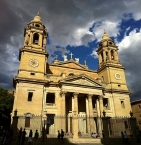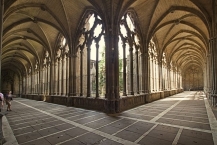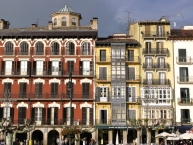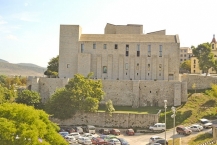Pamplona
Sehenswürdigkeiten
Erstellt am 06.03.2015,
zuletzt geändert von biroto-Redaktion am 08.12.2022
Radwege und Fahrrad-Touren in der Nähe
| Name/Bezeichnung | Typ | km zur Strecke |
|---|---|---|
Route | 0,0 km | |
Route | 0,0 km | |
Route | 0,0 km | |
Tour | 0,0 km | |
Tour | 0,0 km | |
Tour | 0,0 km | |
Tour | 0,0 km | |
Tour | 0,0 km |
![]()
Bitte warten - Kartendaten werden geladen
Art der Sehenswürdigkeit
Historisches Ortsbild
Name u. Anschrift
Pamplona
ES-31001 Pamplona
GEO-Daten
GEO-Koordinaten
42.81∎∎∎∎ -1.64∎∎∎∎
Höhe
455 m
Kommunikation
Informationen zu Urheber-Rechten | |
|---|---|
Rechte-Inhaber | |
Rechte-Ausprägung / Lizenz | by-sa: CREATIVE COMMONS Namensnennung, Weitergabe unter gleichen Bedingungen |
Link zur Rechtebeschreibung | |
Bild übernommen aus | |
Bild hochgeladen | durch biroto-Redaktion am 19.03.2015
|
Informationen zu Urheber-Rechten | |
|---|---|
Rechte-Inhaber | |
Rechte-Ausprägung / Lizenz | by-sa: CREATIVE COMMONS Namensnennung, Weitergabe unter gleichen Bedingungen |
Link zur Rechtebeschreibung | |
Bild übernommen aus | commons.wikimedia.org/wiki/File:Claustro_Catedral_Pamplona.jpg |
Bild hochgeladen | durch biroto-Redaktion am 19.03.2015
|
Informationen zu Urheber-Rechten | |
|---|---|
Rechte-Inhaber | |
Rechte-Ausprägung / Lizenz | by-sa: CREATIVE COMMONS Namensnennung, Weitergabe unter gleichen Bedingungen |
Link zur Rechtebeschreibung | |
Bild übernommen aus | commons.wikimedia.org/wiki/File:Pamplona-architecture-baltasar-21.jpg |
Bild hochgeladen | durch biroto-Redaktion am 19.03.2015
|
Informationen zu Urheber-Rechten | |
|---|---|
Rechte-Inhaber | |
Rechte-Ausprägung / Lizenz | by-sa: CREATIVE COMMONS Namensnennung, Weitergabe unter gleichen Bedingungen |
Link zur Rechtebeschreibung | |
Bild übernommen aus | commons.wikimedia.org/wiki/File:Nafarroako_Errege_jauregia._Euskal_Herria.jpg |
Bild hochgeladen | durch biroto-Redaktion am 19.03.2015
|
Pamplona (Spanish: [pamˈplona]; French: Pampelune; English: Pampeluna) or Iruña (Basque: [iɾuɲa], alternative spelling: Iruñea, IPA: [iɾuɲea]) is the historical capital city of Navarre and of the former Kingdom of Navarre.
The city is famous worldwide for the running of the bulls during the San Fermín festival, which is held annually from July 6 to 14.
See
Several notable churches, most of its 16th- to 18th-century fortified system and other civil architecture buildings belong to the historic-artistic heritage of Pamplona.
Religious architecture
The most important religious building is the fourteenth century Gothic ⊙Cathedral , with an outstanding cloister and a Neoclassical façade.
There are another two main Gothic churches in the old city: ⊙Saint Sernin and ⊙Saint Nicholas , both built during the thirteenth century.
Two other Gothic churches were built during the sixteenth century: ⊙Saint Dominic and ⊙Saint Augustine.
During the seventeenth and eighteenth century were built the Baroque chapels of Saint Fermin, in the church of ⊙Saint Lawrence, and of the Virgin of the Road (Virgen del Camino), in the church of ⊙Saint Sernin, the convents of the Augustinian Recollect nuns and the Carmelite friars, and the ⊙Saint Ignatius of Loyola basilica in the place where he was injured in the battle and during the subsequent convalescence he decided to be a priest.
The most remarkable twentieth century religious buildings are probably the new diocesan seminary (1931) and the classical-revival style memorial church (1942) to the Navarrese dead in the Nationalist side of the Civil War and that is used today as temporary exhibitions room.
Military and civil architecture
From the prominent military past of Pamplona remain three of the four sides of the city walls and, with little modifications, the ⊙citadel or star fort. All the mediaeval structures were replaced and improved during 16th, 17th and 18th centuries in order to resist artillery sieges. Completely obsolete for modern warfare, they are used today as parks.
The oldest civil building today existing is a fourteenth-century house that was used as ⊙Cámara de Comptos (the court of auditors of the early modern autonomous kingdom of Navarre) from the sixteenth to the nineteenth century.
There are also several medieval bridges on the Arga: Santa Engracia, Miluce, Magdalena, and San Pedro.
The medieval ⊙palace of Saint Peter, which was alternatively used by Navarrese kings and Pamplonese bishops, was used during the early modern age as the Viceroy's palace and later was the seat of the military governor of Navarre; from the time of the Civil War it was in ruins but was recently rebuilt to be used as the General Archive of Navarre.
The most outstanding Baroque civil architecture is from the eighteenth century: ⊙town hall, ⊙episcopal palace, Saint John the Baptist seminary, and the Rozalejo's, Ezpeleta's (today music school), Navarro-Tafalla's (today, the local office of PNV), and Guenduláin's (today, a hotel) mansions. The provincial government built its own Neoclassical palace, the so-called Palace of Navarre, during the nineteenth century.
Late nineteenth and early twentieth century Pamplonese architecture shows the tendencies that are fully developed in other more important Spanish cities: La Agrícola building (1912), several apartment buildings with some timid modernist ornamentation, etc. The most notable architect in twentieth century Pamplona was Víctor Eusa (1894–1979), whose designs were influenced by the European expressionism and other avant-garde movements.
Schlafen
Im Umkreis von 4 km:
- ⊙ Hotel en Pamplona Maisonnave, Pamplona, PG VII - IX
"... hinter der Rezeption."
- ⊙ Hotel Pamplona Catedral, Pamplona, PG VI
"... wir haben einen abschließbaren Stellplatz für die Fahrräder für die Nacht!"
Nützliche Information
Im Umkreis von 4 km:
- ⊙ Tourist-Information Pamplona, Pamplona/Iruña
Informationen zu Urheber-Rechten
Rechte-Ausprägung / Lizenz
by-sa: CREATIVE COMMONS Namensnennung, Weitergabe unter gleichen Bedingungen
Link zur Rechtebeschreibung
Text(e) übernommen von:
Wikipedia contributors, 'Pamplona', Wikipedia, The Free Encyclopedia, 18 February 2015, 12:04 UTC, http://en.wikipedia.org/w/index.php?title=Pamplona&oldid=647698274
 [accessed 5 March 2015]
[accessed 5 March 2015]übernommen / bearbeitet am
06.03.2015 - 08.12.2022
übernommen / bearbeitet durch
- ⊙ Hotel Pamplona Catedral, Pamplona, PG VI
Radwege und Fahrrad-Touren in der Nähe
| Name/Bezeichnung | Typ | km zur Strecke |
|---|---|---|
Route | 0,0 km | |
Route | 0,0 km | |
Route | 0,0 km | |
Tour | 0,0 km | |
Tour | 0,0 km | |
Tour | 0,0 km | |
Tour | 0,0 km | |
Tour | 0,0 km |
Erstellt am 06.03.2015,
zuletzt geändert von biroto-Redaktion am 08.12.2022




